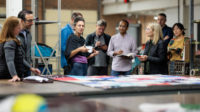Factory Towns of South China: An Illustrated Guidebook
Where All Your Stuff Comes From
Open this book and you cannot help but think of Great Leap Forward, the 2001 tome generated by Rem Koolhaas and his colleagues at the Harvard Design School Project on the City. Both books are university-based, research-driven, essay-enhanced, muddy-photography-filled studies of urbanism in the Pearl River Delta (PRD), the manufacturing center of China. The dozen years between Great Leap's “initial overview” and this “critical evaluation” have been filled with enormous progress (or, some say, regress). In Factory Towns of South China, editor Stefan Al provides an in-depth guide to the changed and changing landscape of the PRD, adding all-important detail to what many experience only through media sound bites.

The first part of Factory Towns includes texts on urbanization, demographics, economics, and infrastructure in south China. By fitting 12 essays and numerous charts into 60 pages, Al chose breadth over depth. This is not a bad thing, as it covers many key topics and contains writing of high quality. Works ranging from Claudia Juhre's data-filled essay on environmental degradation to Minnie Chan's journalistic take on worker strikes to Rex Wong's thoughtful discussion of the effects of governmental policy on design are much more than CliffsNotes to the PRD. I would have liked a detailed text on the factory towns that have been abandoned or converted to other uses, a new phase of development that Al and others only hint at. But this is a minor quibble with an otherwise thorough introduction.
The second part—the bilingual “illustrated guidebook” of the subtitle—looks at factory towns in six metropolitan areas: Hong Kong, Shenzhen, Dongguan, Guangzhou, Foshan, and Zhongshan. The highly visual guidebook form (think Eyewitness, not Lonely Planet) is a clever device, as it is likely that most readers will never actually visit, say, Donghuanjie Town's Video Game Machine Factory. Detailed research from graduate students in the urban-design program at the University of Hong Kong takes the armchair traveler there. The guide includes brief histories of each city's development, descriptions of the products made in each factory, and steps along the production line—specifics that make a place interesting. Precise maps and clearly rendered isometric drawings of factories and associated housing say “you are here.” Some aspects of the guide—repetitive pictures of canteen lunches, interviews with workers who reveal little, and somewhat overwrought graphic design—are less successful. But it is fun to flip through the book, to look through a window into a world that has such import on the rest of the planet. For me, though, the book's essays are the place where readers will want to spend the most time.



